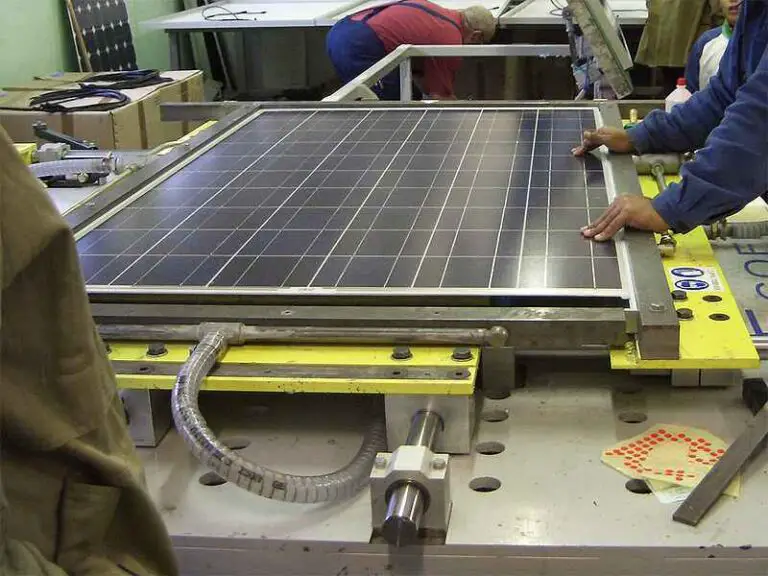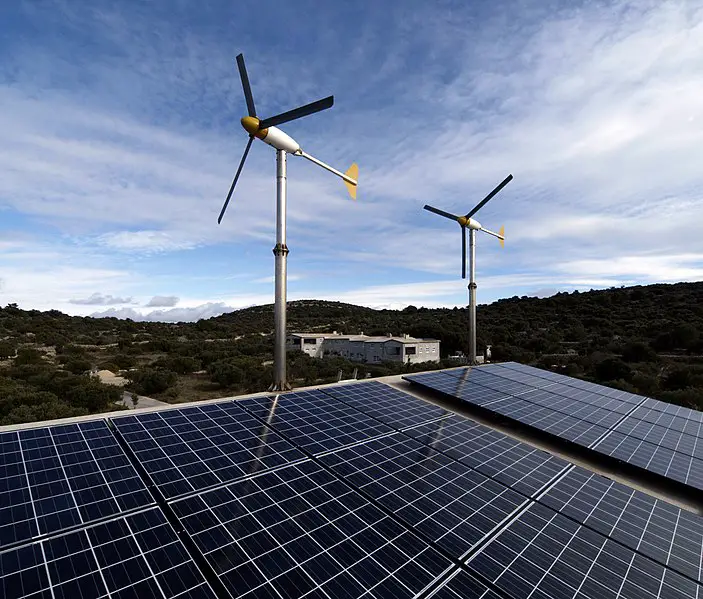3 Types of Offshore Wind Turbines Explained
Types of offshore wind turbines are; fixed, floating, and hybrid offshore wind turbines.
This article discusses the types of offshore wind turbines, as follows;
1). Fixed Offshore Wind Turbine (as one of the Types of Offshore Wind Turbines)
Fixed offshore wind turbine is a type of offshore wind turbine that is designed to remain positionally stable throughout its operational lifetime, using firm, rigid supporting structures.
Sea wind turbines are fixed by attaching them to foundations made from mechanically-resilient materials like steel and concrete; which are then installed firmly to the shallow parts of the seafloor such as the continental shelf.
There are different types of foundations used with fixed offshore wind turbines, such as tripod, monopile, jacket and gravity-based foundations [4].
Selection of a suitable foundation is usually carried out with consideration of factors like turbine size and weight, seafloor/water depth, and reliability of point-anchorage.
The use of fixed offshore wind turbines is recommendable only in relatively-shallow areas of the sea, where the water depth is less than or equal to 50 meters [2]. Beyond this depth range, fixed foundations may be difficult, risky to install, expensive, and generally unreliable.
A major advantage of fixed offshore wind turbines is their stability.
As a renewable energy technology, a fixed offshore turbine offers the option of easy traceability. This can be very helpful in cases where a single turbine must be identified (and perhaps repaired) among multiple turbines; such as in an offshore wind farm.
At the same time, they provide greater access to wind energy in larger and more-consistent supply than their onshore counterparts.
The disadvantages of fixed offshore wind turbine include its geographic limitation, which makes it able to capture energy only within its fixed range. It can also require more structural maintenance, especially where ocean currents have significant impact on foundation stability.

2). Floating Offshore Wind Turbine
Floating offshore wind turbine is a type of offshore wind turbine that is installed upon floating structures without any foundation on the sea floor.
The use of floating offshore wind turbine is recommendable where water depth exceeds 60 meters. It makes wind energy development possible in the deep sea, where there is often surplus supply of air currents.
There are there floating offshore wind farms in the world as of January 2023; including Windfloat Atlantic in Portugal, and Hywind in Scotland [1]. These wind farms have performed generally well in delivering electricity to many human-occupied areas.
In other parts of the world like Norway, offshore floating wind turbines have been installed singly.
Floating offshore wind development has the potential to reduce the cost of offshore wind energy, by using simpler structural designs and mobility-induced flexible wind capture.

3). Hybrid Offshore Wind Turbine (as one of the Types of Offshore Wind Turbines)
Hybrid offshore wind development refers to the development of offshore wind technologies that perform cogeneration, by harnessing more than one energy resource simultaneously.
A hybrid wind turbine is a turbine that combines the essential characteristics of more than one type of turbine. An example of this is a turbine with attributes of more than one foundation design, or mode of operation.
The hybrid wind electric system works by utilizing its various components to capture and convert energy, which could be of the same or different types.
A common example of hybrid offshore wind turbine (HOWT) is the wind and wave system; which is equipped with converters that generate wave power simultaneously as wind [3].
Hybrid wind turbines may also be equipped with solar panels for capturing and converting solar energy.
The hybrid offshore wind concept optimizes energy production and increases the energy efficiency of power systems, while conserving space.
Conclusion
Types of offshore wind turbines are;
1. Fixed Offshore Wind Turbine
2. Floating Offshore Wind Turbine
3. Hybrid Offshore Wind Turbine
References
1). Bento, N.; Fontes, M. (2018). "Emergence of floating offshore wind energy: Technology and industry." Available at: https://doi.org/10.31230/osf.io/ma7ku. (Accessed 22 January 2023).
2). Ma, K-T.; Wu, Y.; Stolen, S. F.; Bello, L.; van der Horst, M.; Luo, Y. (2021). "Mooring Designs for Floating Offshore Wind Turbines Leveraging Experience From the Oil & Gas Industry." ASME 2021 40th International Conference on Ocean, Offshore and Arctic Engineering. Available at: https://doi.org/10.1115/OMAE2021-60739. (Accessed 21 January 2023).
3). McTiernan, K. L.; Thiagaraian, K. (2020). "Review of Hybrid Offshore Wind and Wave Energy Systems." Journal of Physics Conference Series 1452(1):012016. Available at: https://doi.org/10.1088/1742-6596/1452/1/012016. (Accessed 21 January 2023).
4). Valk, P. V. (2014). "Coupled Simulations of Wind Turbines and Offshore Support Structures: Strategies based on the Dynamic Substructuring Paradigm." Available at: https://doi.org/10.4233/uuid:ac619319-9eae-443d-8b94-d0246f80ffdb. (Accessed 21 January 2023).

